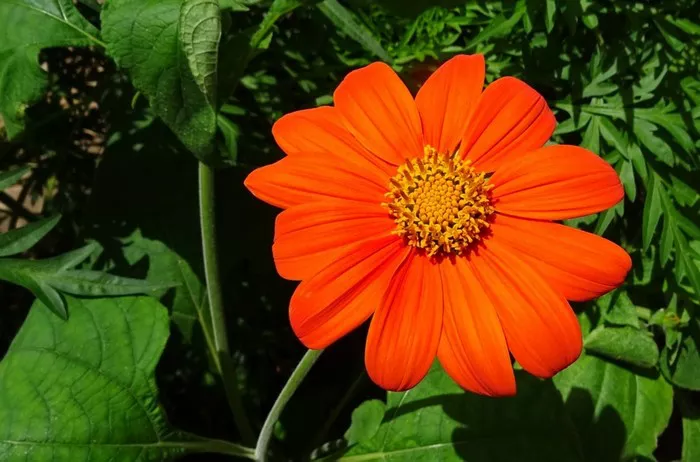In the vast tapestry of floral beauty, few blooms capture the essence of sunshine quite like the Mexican Sunflower (Tithonia diversifolia). With its vibrant hues and commanding stature, this botanical wonder has become a beloved fixture in gardens, landscapes, and ecological restoration projects around the world. In this comprehensive guide, we delve into the anatomy, variations, significance, and cultivation of Mexican Sunflowers, shedding light on their captivating allure.
Anatomy of Mexican Sunflowers
Mexican Sunflowers are renowned for their striking appearance, characterized by tall stems adorned with lush foliage and clusters of brilliant blooms. Let’s dissect the anatomy of these captivating flowers:
1. Stems and Leaves: The stems of Mexican Sunflowers are sturdy and upright, often reaching heights of six feet or more. Their leaves are large, coarse, and deeply lobed, giving them a distinctively tropical appearance. The foliage is typically a rich shade of green, providing a verdant backdrop for the dazzling flowers.
2. Flowers: The hallmark feature of Mexican Sunflowers is, undoubtedly, their radiant blooms. Each flower consists of a prominent central disc surrounded by a ring of vibrant orange or yellow petals. The disc, which resembles a miniature sun, is densely packed with tiny tubular florets, while the petals add a burst of color and flair.
3. Roots: Beneath the soil, Mexican Sunflowers develop a robust root system that helps anchor the plants and absorb nutrients and water from the earth. These roots also play a crucial role in soil stabilization, making Mexican Sunflowers valuable allies in erosion control efforts.
Variations of Mexican Sunflowers
While Mexican Sunflowers are typically associated with their classic orange or yellow blossoms, there are several notable variations and cultivars worth exploring:
1. Golden Torch: This variety features dazzling golden-yellow flowers that gleam like miniature torches in the sunlight. Golden Torch Mexican Sunflowers are prized for their intense coloration and prolific blooming habit, making them a favorite among gardeners and pollinators alike.
2. Fiesta Del Sol: With its cheerful blend of orange and yellow petals, Fiesta Del Sol Mexican Sunflowers evoke the vibrant spirit of a summer fiesta. This eye-catching cultivar adds a splash of festive color to any garden or landscape, attracting bees, butterflies, and other beneficial insects.
3. Red Torch: While orange and yellow are the most common hues associated with Mexican Sunflowers, the Red Torch variety offers a captivating twist with its fiery crimson blooms. These striking flowers stand out against the backdrop of green foliage, creating a dramatic visual contrast that commands attention.
4. Variegated Varieties: For those seeking a more unusual aesthetic, variegated Mexican Sunflowers provide an intriguing option. These cultivars feature petals adorned with unique patterns and color combinations, ranging from splashes of white and pink to streaks of orange and red.
Significance of Mexican Sunflowers
Beyond their ornamental beauty, Mexican Sunflowers hold significant ecological, cultural, and practical importance:
1. Pollinator Magnet: The nectar-rich flowers of Mexican Sunflowers serve as a vital food source for bees, butterflies, and other pollinators. By supporting pollinator populations, these flowers play a crucial role in maintaining healthy ecosystems and promoting biodiversity.
2. Soil Improvement: Mexican Sunflowers are renowned for their ability to thrive in poor soils and harsh conditions. As they grow, their extensive root systems help break up compacted soil, improve drainage, and add organic matter, thereby enhancing soil fertility and structure.
3. Erosion Control: In regions prone to soil erosion, Mexican Sunflowers are valued for their role in stabilizing hillsides, riverbanks, and other vulnerable areas. Their deep-reaching roots bind the soil together, reducing erosion caused by wind and water and helping to prevent landslides and sedimentation.
4. Cultural Symbolism: In Mexican culture, the sunflower holds symbolic significance, representing warmth, vitality, and happiness. Mexican Sunflowers, with their radiant blooms and sun-like appearance, embody these qualities and are often incorporated into festivals, ceremonies, and celebrations.
Cultivating Mexican Sunflowers
Whether you’re a novice gardener or a seasoned horticulturist, cultivating Mexican Sunflowers is a rewarding endeavor. Here are some tips for success:
1. Site Selection: Choose a sunny location with well-drained soil for planting Mexican Sunflowers. These sun-loving plants thrive in full sunlight and require adequate air circulation to prevent fungal diseases.
2. Sowing Seeds: Mexican Sunflowers can be grown from seeds, which should be sown directly into the soil after the last frost date. Plant the seeds at a depth of 1/4 to 1/2 inch and space them 12 to 18 inches apart to allow for proper airflow and growth.
3. Watering and Fertilizing: Keep the soil consistently moist but not waterlogged during the growing season, especially during dry periods. Avoid over-fertilizing, as Mexican Sunflowers are relatively low-maintenance plants that prefer lean soil.
4. Support and Maintenance: Tall varieties of Mexican Sunflowers may benefit from staking or support to prevent them from toppling over in windy conditions. Deadhead spent flowers regularly to prolong the blooming period and encourage new growth.
5. Pest and Disease Management: Mexican Sunflowers are relatively resistant to pests and diseases, but occasional problems such as aphids, caterpillars, and powdery mildew may occur. Monitor the plants regularly and address any issues promptly using organic pest control methods.
6. Propagation: Mexican Sunflowers can be propagated from seeds or by taking stem cuttings. To propagate from cuttings, select healthy, vigorous stems and trim them just below a node. Plant the cuttings in moist soil or a rooting medium and keep them warm and humid until roots develop.
Conclusion
Mexican Sunflowers are not only a feast for the eyes but also valuable contributors to ecosystems, cultures, and landscapes worldwide. By understanding their anatomy, variations, significance, and cultivation requirements, gardeners and enthusiasts can fully appreciate the splendor of these radiant blooms and harness their potential to enrich our lives and the world around us.


